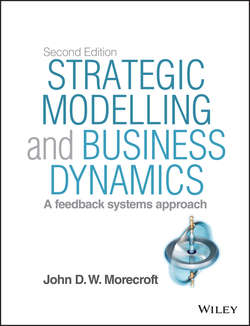Читать книгу Strategic Modelling and Business Dynamics - Morecroft John D. - Страница 11
На сайте Литреса книга снята с продажи.
Preface from the First Edition 3
Modelling for Learning
ОглавлениеAfter more than 10 years at MIT, I returned to England in 1986 to join London Business School. John Stopford made possible this return and I joined him in the School's Strategy department. From this new academic base I entered a productive and enjoyable phase of ‘modelling for learning’. I was invited by Arie de Geus to collaborate with his Group Planning department in Royal Dutch/Shell, based at the headquarters of Shell International in London. There, over a period of six years, a series of modelling projects (some conducted by me, and others conducted by David Kreutzer and David Lane) unfolded within the framework of Arie's ‘planning as learning’ initiative. The idea was to take a fresh view of planning and decision making in organisations and see them as collective learning processes. A vital empirical finding, from educational psychologists' studies of child learning, was that learning and doing often go hand-in-hand; children learn as they play. Arie de Geus made the logical step from child's play to decision making by play. It was a big step. But it was insightful if you took the idea seriously, as he and others in Group Planning did. Modelling and simulation fit naturally with this new approach to planning since models are in essence representations of reality (toys) and simulators allow role-playing with a modelled (and much simplified) reality.
An important consequence of my collaboration with Arie and Shell was the launch, at London Business School, of a week-long residential executive education programme called Systems Thinking and Strategic Modelling (STSM). The programme used learning-by-doing to engage executives with the core principles of feedback systems thinking and system dynamics modelling. Chapter 2 (Introduction to Feedback Systems Thinking) and Chapter 3 (Modelling Dynamic Systems) are derived from STSM. Moreover, the programme brought together, for a period of 10 years, a faculty team at London Business School that helped to develop system dynamics in many important ways and materially contributed to the content of this book. The team members were Arie de Geus, Erik Larsen, Ann van Ackere and Kim Warren and then later Shayne Gary. I enjoyed working with this special group of people and know that together we accomplished a great deal. Thanks to you all.
The shower models in Chapter 4 were sparked by Erik Larsen who felt, in the spirit of modelling for learning, that we shouldn't simply lecture STSM participants about the tricky balancing loop in a shower ‘system’. Instead, we should build a simulator that would allow participants to see (or even experience) the resulting dynamics. So together we developed prototype simulators that became the basis for the World of Showers A and B models in Chapter 4. Alessandro Lomi and Ari Ginsberg later joined us to write a journal article based on these models, entitled ‘The dynamics of resource sharing – a metaphorical model’. Two MBA students at London Business School, Thomas Furst and Derrick D'Souza, helped me to develop an early version of the gaming interface, and my wife Linda Morecroft worked on the user guide and interface enhancements for World of Showers.
There is an anecdote to accompany the shower project. After Erik Larsen and I had formulated the model's equations, we needed to supply parameters. Erik suggested that the ‘desired temperature’ of the shower should be set at 25 °C. I asked him if that number was high enough. He said it didn't matter as the choice would make no difference to the resulting dynamics, which was what we wanted the model to demonstrate. He was right in principle, but in practice (as I discovered by taking a thermometer into my home shower) water at 25 °C feels distinctly cool. Erik was not easily moved by this piece of empirical evidence and so, as an amusing compromise, we decided to locate the model's imaginary shower taker in a hot and humid climate where a cool shower would be both desirable and plausible.
Perhaps the most memorable project from the modelling for learning era was a study of the structure and long-term dynamics of global oil markets. This study, conducted with the help of Kees van der Heijden, led to the Oil Producers' model described in Chapter 8. At the time, Kees was head of Group Planning's renowned scenario development team. He brought together 10 Shell managers who contributed to the model's conceptualisation. The project was a good opportunity to engage these managers with the model building process and to build a model that captured a collective view of their oil world as the basis for subsequent scenario development. The original Oil Producers' model was developed in the iThink modelling language. But several years later, prompted by a suggestion from Erik Larsen, the model's equations were transported into Visual Basic and a dramatic new interface was overlaid as the basis for experimental work on decision making in dynamically complex environments (the global oil industry is certainly dynamically complex). This work was carried out by Paul Langley as part of his doctoral thesis at London Business School (‘An experimental study of the impact of online cognitive feedback on performance and learning in an oil producer's microworld’, November 1995).
Systems Thinking and Strategic Modelling ran twice a year for 15 years and brought system dynamics to hundreds of managers and senior staff from organisations around the world.
